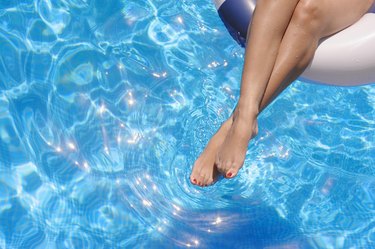
There's nothing like a refreshing dip in the pool on a hot summer day. But sometimes, this romp in the water can mysteriously shred your feet — an unpleasant phenomenon called "pool toe."
Here's everything you need to know about the condition, including what it is, how to treat it and an expert's tips for pool toe prevention.
Video of the Day
Video of the Day
What Is Pool Toe?
It might not be an official diagnosis, but pool toe (or "swimmer's toe") refers to a "peeling or cracking of the bottom of the toes after being in the pool for a long time," Nelya Lobkova, DPM, a podiatrist at Step Up Footcare in New York, tells LIVESTRONG.com.
For the record, the medical name of this skin condition is "keratolysis exfoliativa," and you know you have it if you have peeling, cracked or blistering skin on the bottom of your feet, according to a November 2020 case report and review in Cureus.
You'll first spot a blister on your feet, which probably won't come as a surprise — it is sandal season, after all, and a blister may be easy to dismiss.
But then a curious thing will happen: When the blister opens, you'll see red or irritated skin underneath that later becomes dry or cracked, Dr. Lobkova says. However, this skin usually does not itch, according to DermNet NZ.
What Is Swimming Pool Pulpitis?
Pool pulpitis (also called pool palms) is a similar condition that causes blistering and irritation on your finger pads or palms, according to the Cureus review. Typically, it's the result of making contact with the rough concrete on the sides and edges of the pool.
Why Pool Toe Happens
While the exact reason pool feet happen isn't fully understood, Dr. Lobkova says there are some things that may make you more at risk for the condition:
1. Your Feet Are Irritated
Often, "pool toe is a result of the chlorinated water causing irritation of the outer layer of plantar skin," Dr. Lobkova says.
Other irritants like bleach or detergents can cause the peeling, too, she says.
2. Your Feet Are Sweaty
If you typically have sweatier feet (or have hyperhidrosis, a condition marked by excessive sweating), then your toes spend more time hanging out in a wet or moist environment. This sets the stage for these types of irritation and blisters to develop, Dr. Lobkova says.
3. You Have a Pre-Existing Skin Condition
Having eczema or psoriasis also makes you more prone to pool toe, because these conditions mean that you have a compromised skin barrier, Dr. Lobkova says.
4. You’re Touching the Bottom of the Pool
There's nothing wrong with the bottom of the pool, but the friction from the rough cement may chafe your feet to create the irritation and peeling, according to the Cureus review.
Splitting toes commonly occurs in kids, who typically have more contact with the cement surface as they play in shallower waters. Still, adults can get swimmer's toe, too.
How to Treat Pool Toe
If your feet are roughed up from your latest pool party, you may be on the hunt for pool toe remedies. Here's Dr. Lobkova's advice for pool toe treatment:
- After swimming in a chlorinated pool, rinse off well with warm (not hot) water, and keep showers short (5 to 10 minutes max).
- Keep feet dry. This might mean staying out of the pool and making sure you're wearing footwear and socks that allow for air flow or are sweat-wicking.
- Don't peel the skin. It can be so tough not to, but try to keep your mitts off your feet. "Let it heal on its own," Dr. Lobkova says.
- Moisturize feet with gentle (think: fragrance-free) moisturizers like CeraVe Daily Moisturizing Lotion (Amazon, $11.69), Eucerin Advanced Repair Body Cream (Amazon, $12.19) or Aquaphor Healing Ointment (Amazon, $13.74) to encourage skin barrier repair.
Is It Pool Toe or Athlete's Foot?
Athlete's foot is a fungal infection that can also cause peeling skin on the toes. But, according to the Mayo Clinic, athlete's foot typically comes with a rash that itches, stings and burns. Talk to your doctor if you think you might have athlete's foot, because you'll need an anti-fungal treatment to get rid of it.
How to Prevent Pool Toe
There are a few precautions you can take to help keep feet and toes peel-free this summer. Here are Dr. Lobkova's tips for preventing pool toe:
- First, if you have a known skin condition like eczema or psoriasis that makes you more prone to pool toe, keep swims shorter. (And if your skin condition isn't well-controlled, talk to your doctor about the best ways to manage it.)
- No matter what, remember that splitting, cracking skin means you have a compromised skin barrier and may be more at risk for other infections, so wear footwear around the pool and when going into the bathroom, and moisturize your feet and toes before and/or after swimming.
- Always rinse off after you swim, but keep your rinse to just a few minutes and use warm water instead of hot to avoid irritating or drying out your skin even more.
Is this an emergency? If you are experiencing serious medical symptoms, please see the National Library of Medicine’s list of signs you need emergency medical attention or call 911.


